The Gun - Early Carriages
For some heavy guns made in the 15th century, four-wheeled carriages were especially built but these could not stand the shock of firing. The gun, with or without trunk, had to be unloaded and laid on the ground, for which purpose the use of a gin (sheerlegs) was necessary. Mons Meg's carriage is a typical example. The modern term 'to lay' a gun probably derives from the ancient practice of laying a gun on the ground.
| |
 |
Mons Meg on a replica of her original carriage. The rent in her side was made in 1680 when firing a salute to the Duke of York. After 230 years' service she was finally retired. The Scots blamed the Gunner (who was an Englishman) for the mishap. |
Two-wheeledEventually Gunners realised the advantages of a gun which could be fired from its carriage as well as merely being transported upon it. The first two-wheeled travelling carriage embodying the same basic features as a modern field artillery carriage , ie trail, axletree and wheels, appeared in France in 1461. Until about 1450, guns had no trunnions so the piece had to be secured to the trunk as explained above, while the trunk itself was hinged to the front of the trail so it could be elevated or depressed. The elevating gear shown on the carriage in the figure consisted of a wooden arc (or pair of arcs), with holes through which a pin could be inserted to adjust the trunk to somewhere near the required elevation. There appears to be no means of fine adjustment! | |
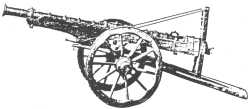 |
Wrought iron BL field gun (Culverin) of Burgundian origin (1460-70). |
|
With the adoption of trunnions there appeared in Germany a type of carriage in which the trunk alone formed both trail and mounting. Still a solid baulk of timber, it was laboriously shaped and hollowed to take the piece. Elevating arrangements resembled those in the figure above. | |
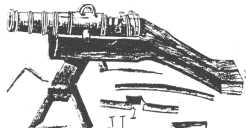 |
A copy of a contemporary print showning a carriage designed by Maximillian (1459-1519) under construction. |
|
Maximillian (or his technicians) also produced a light field gun on a similar carriage in which the shafts provided for draught purposes also acted as the trail in action. | |
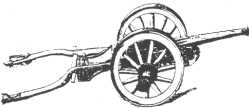 |
Light field carriage in use in Germany c. 1494. |
Double-plate CarriageThe excessive amount of work involved in building a carriage, as well as the amount of timber used, led early in the 16th century, to the introduction of the 'double-plate' carriage, so-called because the trail and mounting consisted of two heavy planks or 'plates' held together by the axletree and two or more transoms. It was simpler to construct but still rather heavy. | |
|
To elevate or depress the gun a simple wedge or quoin supported on a bed formed by one of the transoms was suitably positioned under the breech, the latter being raised or lowered by a handspike. Although the idea of a screw to apply elevation was conceived at least a century earlier, the first practicable screw did not appear until 1578 (in England). Difficulty of manufacture probably precluded its earlier use, as the screw-cutting lathe had not then been invented. | 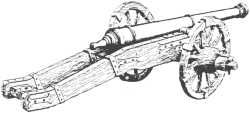 Early 16th century double-plate carriage |
|
To make a screw, a wooden model had first to be carved, then a mould made in clay, and finally a casting produced. Old-time gunmakers often had the ideas but not the technology to put them into practice. The elevating screw enabled elevation and/or depression to be applied much more accurately than with the quoin, and was in general use in field and siege artillery by 1650. However, the quoin survived until the 19th century, especially in the Navy where battles tended to be short-range affairs, and sailors considered the screw too slow. The double-plate carriage continued in use for nearly 300 years in field artillery and longer in siege. Block-trail CarriageIn 1778 experiments began in England on the 'block trail' carriage. In this type, the two heavy planks of the double-plate version were replaced by a trail made from a single 'block' or piece of timber with two 'cheeks' attached to the front as the mounting. These cheeks carried the trunnion bearings. | |
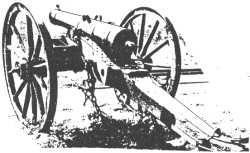 |
Block trail carriage. The gun is the standard British field gun in use up to 1860, the SBML 9-pr. |
|
Probably owing to war commitments the block trail carriage was not actually introduced until 1793. Not only was it lighter than the double plate but it was more easily maneuverable and enabled the team with gun limbered up to make a much tighter turning circle. It was a first for the Royal Artillery and Britain, and was subsequently adopted by all European nations and the United States. The wooden block-trail carriage survived until the introduction of iron carriages around 1870. Its chief disadvantage as seen by modern Gunners was that it limited elevation of the piece to about 15°. This did not matter much up to late 19th century times because tactics plus elementary sighting equipment kept fighting ranges short. But strange as it may seem this obvious disadvantage was repeated with the QF 13- and 18-pr guns adopted in 1903 with their pole-type trails. The pole-type trail was of course analogous with the block-type, except that it was made of steel tubing instead of wood. With the resulting limitation in range both equipments were found wanting during World War 1. .../Limber WL Ruffell previous | index | next | History index | Home | |
 Early guns had no carriages. Next the smaller natures were mounted on 'trunks', ie heavy baulks of timber grooved to receive the piece, the latter being retained in place by iron straps. Later guns of wrought iron (and some of bronze) were fitted with iron rings through which ropes could be passed for the same purpose. Up to about the end of the 14th century guns were taken in ordinary farm carts - or even wheelbarrows - to the battlefield where they were brought into action by being unloaded, laid
Early guns had no carriages. Next the smaller natures were mounted on 'trunks', ie heavy baulks of timber grooved to receive the piece, the latter being retained in place by iron straps. Later guns of wrought iron (and some of bronze) were fitted with iron rings through which ropes could be passed for the same purpose. Up to about the end of the 14th century guns were taken in ordinary farm carts - or even wheelbarrows - to the battlefield where they were brought into action by being unloaded, laid
 upon the ground in the general direction of the target, elevated by being propped up by wooden stakes or other pieces of timber, and chocked at the rear to absorb recoil. In some cases the trunk with its gun was dragged along the ground like a sledge.
upon the ground in the general direction of the target, elevated by being propped up by wooden stakes or other pieces of timber, and chocked at the rear to absorb recoil. In some cases the trunk with its gun was dragged along the ground like a sledge.